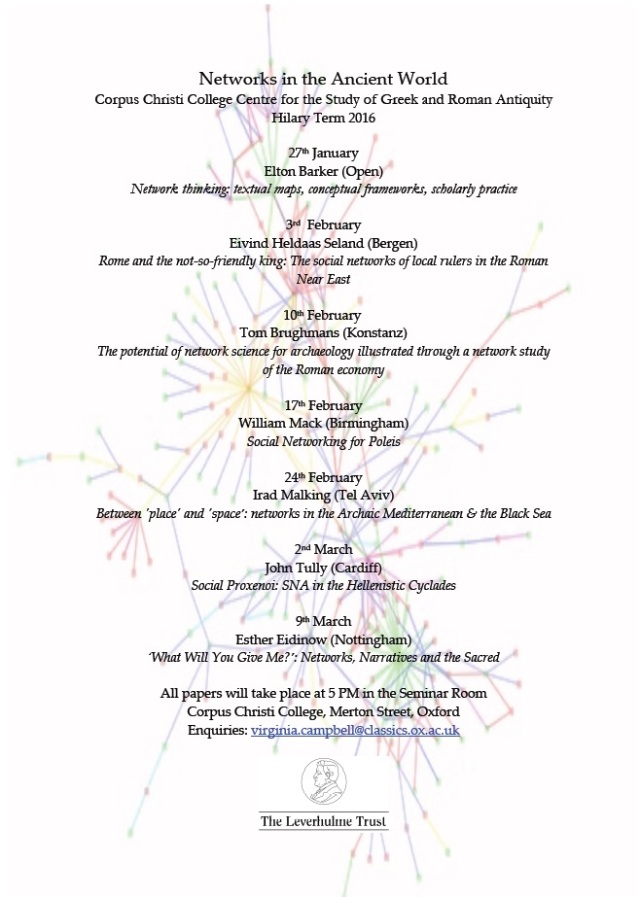In recent months my research has deviated somewhat from social networks to focus more on the processes of elections in Roman Pompeii – what has become a larger project on how the evidence of campaigning remaining from the electoral dipinti can be used to glean a greater understanding of voting in both theory and practice. As a result, I have been giving a series of papers on small parts of this research. Last week I gave a paper for the Roman Discussion Forum, an informal seminar series sponsored by the Institute of Archaeology here in Oxford, looking at Roman naming conventions and the way names are used in the programmata. Interestingly enough, (and with utmost thanks to a colleague, Maria Pretzler, who first told me about this), I found a truly stunning parallel to a number of the issues facing voters in the first century AD in a senatorial race in Alaska in the 21st century.
In 2010,the incumbent senator for the state of Alaska, Lisa Murkowski, chose to run on a write-in campaign after she lost the Republican party primary to Joe Miller, a member of the Tea Party. When she won the election, the fellow Republican she defeated challenged the election results all the way to the state supreme court, attempting to get thousands of ballots thrown out because Murkowski’s name was misspelled. He refuted the idea that a phonetic rendering of Murkowski’s name should be counted as a legitimate vote. As the more than ninety thousand write-in ballots were counted, his representatives questioned them if there was a y for an i, maybe no w, maybe a c instead of a k. They might have seen a smear or just loopy cursive that might — might — be subject to interpretation. As the director of the Alaska Division of Elections said, ‘Not everyone writes perfectly.’ Miller’s claims were rejected, on the basis that Alaska statutes and case law do not require perfect spelling on write-in ballots if voter intent is clear.
Murkowski was well aware of the potential problems a write in campaign would bring regarding ballots themselves, as well as the spelling of her name. She used this in her advertisements which featured mnemonic devices and spelling aids. These not only included information about how to complete a write in ballot properly, but also featured spelling clinics and a spelling bee with a school child correctly completing her name.
As spelling ended up being the primary component of Miller’s lawsuit, Murkowski’s attempt to forestall major problems in that area is understandable. One Alaskan newspaper went so far as to question whether Miller’s lawsuit was an attempt to enforce a literacy test on voters, something that has been illegal in the United States since 1965. It was suggested this move was particularly aimed at the Native Alaskan population, as some of the districts where more than 70% of the ballots cast were write ins are primarily comprised of native residents.
Many of the issues raised in Alaska six years ago are the same problems I keep running up against in examining the political processes of campaigning and voting in a Roman town in the first century AD. Names – how they are spelled or written and by whom, whether in dipinti or on a ballot itself, literacy levels of the voting population, ballot legibility, and awareness of who a name represented are fundamental issues surrounding the casting of a vote in the ancient world. A large part of this, is how names are presented, specifically in terms of what we might expect to find, what is actually useful to the voter or the vote counter, and the reality as evidenced in the electoral programmata of Pompeii.
The majority of the electoral programmata in Pompeii are posted for men who have adopted the full tria nomina that became the standard of naming conventions by the late first century BC. (There are a limited number that date to the earliest years of the colony that consist of only two names, using praenomen and nomen.) When using the tria nomina, as Dickey has pointed out, there are eight possible permutations for what name, or combination of names, one could chose to address a Roman man:
– all three names- praenomen + nomen
– praenomen + cognomen
– nomen + cognomen
– cognomen + nomen
– praenomen
– nomen
– cognomen
Ignoring for the moment the men who campaign for magisterial office in Pompeii using four names, thus increasing the number of possible combinations (think, for example, of Gaius Calventius Sittius Magnus or Marcus Lucretius Decidianus Rufus), the number of naming options is going to have an impact on how one is presented in the dipinti advertising one’s candidacy. This is clear in many of the examples found in the electoral programmata. Lucius Popidius Secundus, a candidate for aedile in AD 79, has dipiniti that present his name in four of the possible forms, and with additional abbreviations and shortenings. His name appears as:
Lucius Popidius Secundus
Popidius Secundus
Lucius Popidius
Lucius Popidius Secum
Lucius Popid Secundus
Lucius Pop Secund
Popidius Sec
LPS
LP
This sort of list is possible for virtually every well-documented candidate. In addition, there are a large number of single name programmata which could be attributed to this man or a number of other candidates. There are more than a hundred dipinti naming a Popidius (46 in all) or a Secundus (94 texts). Interestingly, when going with the single name option, the cognomen appears, from this example, to be preferable to the nomen. In either case, the use of a single name may be seen as a way to capitalize on epigraphic material that is not your own. Why not let the voting populace assume that you are the same Popidius that ran for office a few years before, or the same Secundus who has already been successfully elected. This concept, of using another’s name or initials to your own ends in an election, is not unheard of in the ancient literature (or even modern elections – case in point – many Americans thought they were electing George Bush the father as president, not George W. Bush the son). A discussion by Cicero of one candidate trying to bypass a step on the cursus honorum all together by having the same initials as another magistrate is, in fact, used as evidence for voting by initials only. Regardless of the form of name or how it is abbreviated, what likely seems to be of the utmost importance in getting elected was that the intent was clear on the part of the voters, and that this could be transferred from the campaign to the voting booth, much like in an Alaskan senate race.





